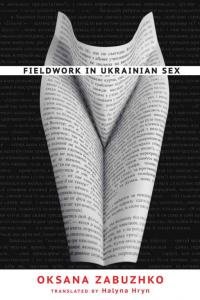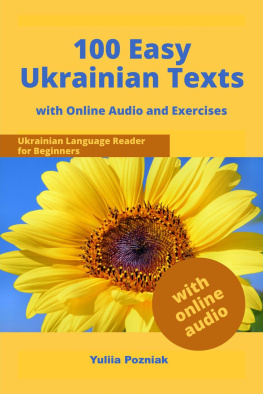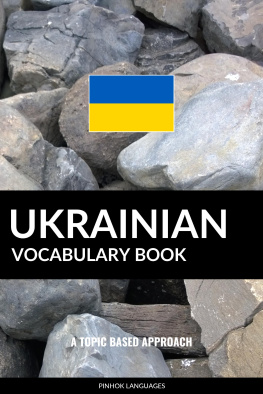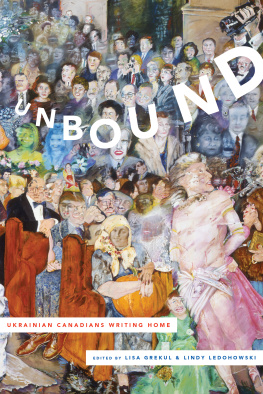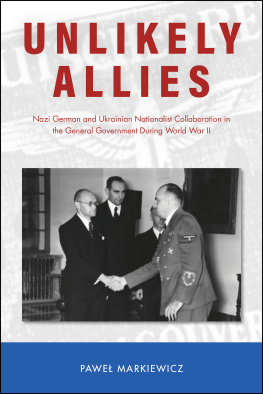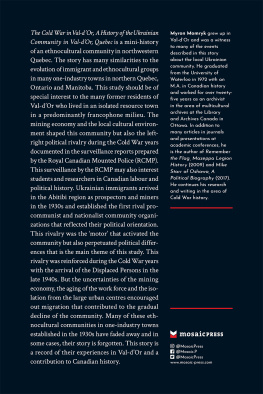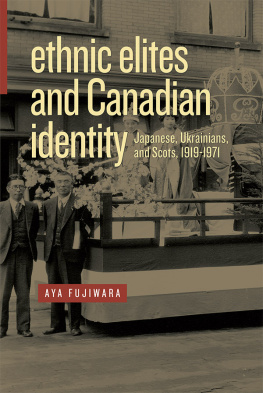Table of Contents
Guide

Studies in Immigration and Culture
Royden Loewen, Series editor
1 Imagined Homes
Soviet German Immigrants in Two Cities
Hans Werner
2 Mennonite Women in Canada
A History
Marlene Epp
3 Sounds of Ethnicity
Listening to German North America, 18501914
Barbara Lorenzkowski
4 Families, Lovers, and their Letters
Italian Postwar Migration to Canada
Sonia Cancian
5 Storied Landscapes
Ethno-Religious Identity and the Canadian Prairies
Frances Swyripa
6 Community and Frontier
A Ukrainian Settlement in the Canadian Parkland
John C. Lehr
University of Manitoba Press
Winnipeg, Manitoba
Canada R3T 2M5
uofmpress.ca
John C. Lehr 2011
Second printing
Printed in Canada
Text printed on chlorine-free, 100% post-consumer recycled paper
All rights reserved. No part of this publication may be reproduced or transmitted in any form or by any means, or stored in a database and retrieval system, without the prior written permission of the University of Manitoba Press, or, in the case of photocopying or any other reprographic copying, a licence from Access Copyright (Canadian Copyright Licensing Agency). For an Access Copyright licence, visit www.accesscopyright.ca, or call 1-800-893-5777.
Cover and interior design: Karen Armstrong Graphic Design
Maps: Weldon Hiebert
Cover image: William Kurelek, The Ukrainian Pioneer, No. 3 (detail), 19711976. Photo National Gallery of Canada. National Gallery of Canada, Ottawa. Transfer from the House of Commons of the Parliament of Canada, 1990.
Library and Archives Canada Cataloguing in Publication
Lehr, John
Community and frontier : a Ukrainian settlement in the Canadian parkland / John C. Lehr.
(Studies in immigration and culture, 1914-1459 ; 6)
Includes bibliographical references and index.
ISBN 978-0-88755-725-5 (pbk.)ISBN 978-0-88755-407-0 (e-book)
1. Ukrainian CanadiansManitobaStuartburn RegionHistory.
2. Ukrainian CanadiansManitobaStuartburn RegionSocial conditions.
3. Frontier and pioneer lifeManitobaStuartburn Region.
4. Stuartburn Region (Man.)History. 5. Stuartburn Region (Man.)
Biography. I. Title. II. Series: Studies in immigration and culture ; 6
FC3400.U4L426 2011 971.274 C2011-901110-7
The University of Manitoba Press gratefully acknowledges the financial support for its publication program provided by the Government of Canada through the Canada Book Fund, the Canada Council for the Arts, the Manitoba Department of Culture, Heritage, Tourism, the Manitoba Arts Council, and the Manitoba Book Publishing Tax Credit.

CONTENTS
Photographs follow page 152
ACKNOWLEDGEMENTS
This book could not have been written without the assistance of many people. over the years, the University of Winnipeg and the Social Sciences and Humanities Research Council of Canada have financially supported the research on which this book is based. I wish to thank Jeffrey P. Morski for his assistance in translating material from the Ukrainian-language press and for his companionship and help during a research trip to western Ukraine in 1998; dr. Natalia Aponiuk, my colleague at the University of Manitoba, for translation of materials, advice on transliteration procedures, and invaluable assistance with field research in western Ukraine in 2005, 2006, and 2008. I am indebted to my colleague dr. Yossi katz of Bar Ilan University, Israel, for pointing out the effects of Jewish religious rules on Jewish pioneer merchants operating in gentile frontier communities. Chris kostecki and his colleagues in the Archives of Manitoba patiently answered my inquiries and calls for help when I was searching for information. Ed Ledohowsky suggested sources for maps and on occasion shared in the field research. Jenera Franklin, curator of Manitoba Hydro Archives, introduced me to the relevant materials in the collection and was helpful in many ways. The late Michael Ewanchuk generously gave of his time and expertise over many years, shared his experiences, and made available his field notes of interviews that he had conducted in the area over three or more decades. MaryAnn Mihychuk provided a copy of the memoirs written by her late uncle, Wasyl Mihaychuk. John Machula of Vita and Nick Machnee of gardenton shared their knowledge of the district in the 1930s with me on a number of occasions; in Winnipeg, Jack Sine kindly provided railway timetables for the cnrs Ridgeville Extension, and Anne MacVicar generously shared her expertise in researching land titles. dr. gordon goldsborough provided data on early automobile registrations in Manitoba. My thanks go to them all.
The cooperation of the administrators of the communities embraced by this study was crucial for its completion. My thanks go to Judy Reimer, secretary-treasurer of the rm of Stuartburn: Reeve Bev Berrington and Helen Robbins, chief administrative officer of the rm of Franklin; Reynald Pretiau, secretary-treasurer of the rm of Piney; and Jeanette Sabourin, secretary-treasurer of the town of Emerson for their assistance and granting access to their municipal archival materials.
My thanks go to my colleagues at the University of Winnipeg, Weldon Hiebert and Brian Macgregor, who respectively prepared many of the maps and researched and mapped the schools in the area.
A number of University of Winnipeg geography students also assisted with archival research: Emily Levitt and Lawrence Isaac were invaluable and able research assistants who spent countless hours in the Archives of Manitoba abstracting data from the Homestead Records and combing regional newspapers for information about economic development in the Stuartburn colony; teresa dyck tracked down information on the building and abandoning of the railway line through the colony; Wes toews pieced together a map of early communications in the area; Aaron James plotted and manipulated data; and Laura Redpath diligently combed the school formation files and determined the locations of schools. Brittany Shuwera, whose home was in Caliento before she became a student at the University of Winnipeg, loaned me her babas family history. Without their help, this project would have been burdensome indeed.
One of the most rewarding aspects of this study was the opportunity to meet the people of the Stuartburn area. I particularly want to thank Linda Shewchuk of the gardenton Museum for her interest and encouragement. In the early 1970s, I was privileged to interview some who had taken part in the settlement of the area, either as young adults in the first decade of the past century or as children helping their parents to build new lives on the western Canadian frontier. Their stories were inspiring and their insights invaluable. two anonymous referees evaluated an earlier draft of the manuscript and made insightful and helpful comments, as did Roy Loewen, the editor of the series of which this book is a part. My greatest debt, however, is to my wife, kay, who accompanied me on numerous trips to the district, worked alongside me in archives, and served as my sounding board over the many years that I have pursued my passion for the history of Ukrainian pioneer settlement. I thank them all.
One of the most rewarding aspects of this study was the opportunity to meet the people of the Stuartburn area. I particularly want to thank Linda Shewchuk of the Gardenton Museum for her interest and encouragement. In the early 1970s, I was privileged to interview some who had taken part in the settlement of the area, either as young adults in the first decade of the past century or as children helping their parents to build new lives on the western Canadian frontier. Their stories were inspiring and their insights invaluable.


